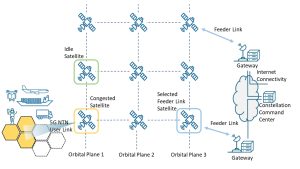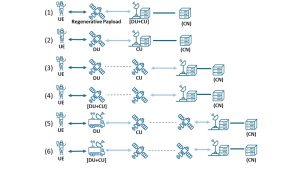The unprecedented service requirements demanded by the forthcoming 6G system call for a complete unification of terrestrial and non-terrestrial networks, suitably supported by converged standards and service-oriented network architecture able to seamlessly adapt to very diverse service and network dynamics.
The unification of terrestrial and non-terrestrial networks (NTN) has proven to be a compelling need to achieve a converged system architecture able to serve very diverse vertical sectors and related users, notably including PPDR, mobile transportation, societal needs, and industry 4.0. From this standpoint, the traditional approach of integrating heterogeneous network access technologies by extending or complementing the already well-defined air- and network-interfaces cannot be considered a viable approach any longer.
The motivations for a more modern converged system architecture stem from the convergence of multiple network technologies, all exhibiting very different peculiarities and, hence, calling for a more cohesive and transversal approach. Further to this, the recent service categorisation defined in the context of IMT-2030 clearly outlined the importance of service ubiquity also enabled by distributed intelligence. In this respect, a native NTN component as part of the forthcoming 6G system design is recognised as strictly pivotal to enabling new services and supporting the existing ones with better performance. However, such a unification process also opens up the door to formidable communication and networking challenges, introduced by the time-variant nature of NTN network topologies and dynamic fluctuations of data traffic and user service subscription. This extreme dynamism of the unified network system calls for a polymorphic design of the overall network architecture, able to timely and efficiently adapt to diverse service requirements and network operations/conditions. In this respect, the potentials offered by a self-organised networking paradigm are considered particularly promising, in that it can support the latest trends in terms of direct-to-satellite connectivity and to leverage the latest advancements in the context of network softwarisation and related automation.
What is the 5G-STARDUST project?
In this multi-folded framework, the 5G-STARDUST project is playing an important role towards the materialisation of such a planned convergence between terrestrial and non-terrestrial networks in the short term, i.e. focusing on the realisation of the so-called 5G-Advanced standardisation wave from 3GPP and paving the way towards 6G systems.
In more detail, 5G-STARDUST (Satellite and Terrestrial Access for Distributed, Ubiquitous, and Smart Telecommunications) is a European project funded within the Smart Network Service (SNS) Joint-Undertaking (JU) initiative as part of the Horizon Europe programme. The project started on 1 January 2023 and will run until 31 December 2025, with the ultimate goal of demonstrating the achieved convergence between terrestrial and non-terrestrial networks by means of advanced laboratory testbeds.
In particular, the project is aimed at demonstrating the feasibility of gNB in space, by exploiting a self-organised networking paradigm architecture and a unified radio interface. In particular, the project has been developing key functionalities to achieve optimised system performance and network automation, by means of novel AI-based strategies applied to Radio Resource Management (RRM), multi-link connectivity, and network slicing. The final main outcome of the project will be to prove the explored concepts and the related developed building blocks in a fully integrated proof-of-concept (PoC), run in a dedicated lab setup hosted by the project partner, Thales Alenia Space France, in the Toulouse (France) premises.
Flexible network architecture
As aforementioned, the main enabler for such a multi-service, multi-network concept is a flexible and modular architecture able to suitably adapt its functions according to the specific users’ needs and network conditions.
In the case of an NTN-integrated 5G/6G system, achieving such a versatile network architecture becomes even more challenging because of the nature of non-geosynchronous orbit (NGSO) satellite systems in terms of mobility of space nodes with respect to ground, often giving rise to handover events. Furthermore, the dotation of 5G/6G functionalities calls for the deployment of gNB in space, which is severely constrained by the current capabilities of satellite systems in terms of size, power, and storage. To this end, the project has come up with a flexible system architecture able to distribute gNB functionalities and overall 5G/6G functionalities in space, which can be activated according to the specific service or traffic conditions being time-wise experienced. Different options have been explored, starting from the well-consolidated practices from 3GPP and O-RAN bodies with respect to ‘functional splitting’, in order to find a proper trade-off between computational complexity, network functions available at the edge, and incurred control plane signalling.
In general terms, all satellites are expected to be 5G-native but the corresponding functionalities will be activated according to network orchestration, slicing, and ultimately service function chaining principles. Such an activation will be triggered either directly from ground or even in space, in the case a core network is entirely implemented onboard satellites. In this respect, proper co-ordination and convergence between terrestrial and non-terrestrial subnetworks is fundamental to carry out effective communication operations, especially in the case of multi/dual-connectivity implementation, whereby traffic segregation, sharing, or offloading from one network to another have to be carried out.
Data distribution
Last but not least, efficient data distribution across the space segment benefits from full interconnected space nodes, also from a control plane perspective.
To this end, the availability of inter-satellite links and the corresponding deployment of routing-in-space solutions is an absolute need, as also confirmed by the ongoing evolution of existing satellite constellation. Beyond what is currently available and promoted by the existing systems, the 5G-STARDUST project furthers the concept of service-oriented architecture also from a data forwarding/routing standpoint, for which a goal of a semantic routing approach is being engineered also based on the experience from other ongoing research activities. In essence, the full softwarisation of the space segments is taken as a key enabler to achieve more service-oriented data communication operations and hence to pave the way towards a new generation of 6G-enabled satellite systems.
In conclusion, 5G-STARDUST is targeting very ambitious goals, aimed at demonstrating the potentials of converging regenerative satellites with terrestrial infrastructures in a number of perspective scenarios. Finally, the project is importantly contributing to the standardisation in 3GPP, in order to mature the current specifications part of the overall 5G-Advanced wave towards the conception of 6G network system elements.
5G-STARDUST project has received funding from the Smart Networks and Services Joint Undertaking (SNS JU) under the European Union’s Horizon Europe research and innovation programme under Grant Agreement No 101096573. This work has received funding from the Swiss State Secretariat for Education, Research and Innovation (SERI).
Please note, this article will also appear in the 20th edition of our quarterly publication.












